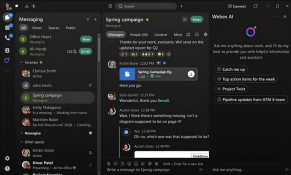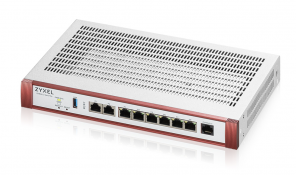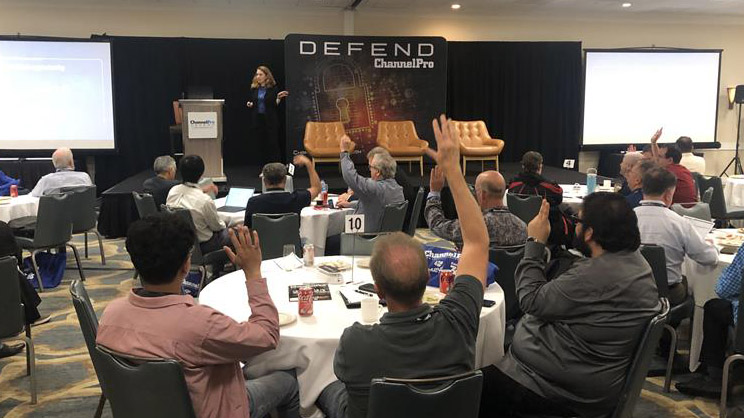The World Series ended in November, another example of scope creep infecting every industry. The good news? The Texas Rangers won their first World Series. But while the Dallas Cowboys draw huge TV crowds, the Texas Rangers and Arizona Diamondbacks series ranks as the least-watched in TV history. Maybe creeping into competition with the NBA wasn’t a good idea after all.
News from big names. Partner news abounds from HP, which consolidated all solutions and services into one globalpartner program and introduced the new Amplify Distribution Program. Commercial partner upgrades include the More for More rate multiplier, Fast Lane for MDF disbursement, and more. 
Meanwhile, HPE’s Partner Ready Vantage program is now fully open, and covers offerings across edge, hybrid cloud, and AI.
The AI strategy at Cisco now includes new Real-Time Media Models, an addition to Webex that puts AI to work on audio and video along with text, as well as Webex AI Assistant (pictured) which applies new goodies across the full Webex portfolio.
Lenovo and NVIDIA teamed up to announce hybrid solutions supported by the new Lenovo AI Professional Services Practice using NVIDA AI Foundations cloud service running with on-prem Lenovo systems powered by NVIDIA. But wait, there’s more! Lenovo execs outlined their AI for All vision, which integrates individuals and enterprises around the world while keeping data secure.
Security news. In another team up, Veeam and Sophos announced that Veeam Data Platform will integrate with Sophos MDR to better secure files before, during, and after backup operations. But wait! Update 23H of Veeam Data Platform includes more advanced data security, malware detection, and other capabilities. 
MSPs can now offer 24/7 threat detection and response services with the new WatchGuard MDR cybersecurity service (pictured, kind of).
Another partnership, as Syncro and Acronis connect to provide backup and storage management tools within Syncro PSA.
The new Bitdefender Offensive Services portfolio adds penetration testing and red team simulated attacks to your cybersecurity toolkit.
Hello to Singularity Threat Intelligence from SentinelOne, which offers an end-to-end threat landscape view with actionable insights to minimize risk.
The newly-revved Check Point Infinity Global Services suite adds NOC and SOC as a service, provides cloud security experts to help cloud migration, and extends MDR/MPR with Microsoft Sentinel.
Proofpoint promoted Remi Thomas from CFO to CEO to replace Ashan Willy. In addition, Proofpoint signed the papers to acquire Tessian, a leader in AI-based email security. Terms were not disclosed.
Tech company Alludo renamed Parallels Awingu, which it acquired last year, to Parallels Secure Workspace.
Judy Security pulled the curtain on Judy Control Center with multi-tenant reporting, analytics, and guidance for MSPs and MSSPs.
IoT news. Claiming to be the first software-defined LAN with native zero trust, the new Versa Secure SD-LAN provides IoT security for campus and branch networks.
One great value (curse?) of technology is that everything eventually touches everything. Now, IoT is making software developers change to accommodate that togetherness.
The decision between custom and off-the-shelf IoT projects for enterprises seems to have created a paralysis by analysis.
Standards and consensus frameworks speed tech adoption, which may be why the Industry IoT Consortium just published the Digital Twin Core Conceptual Models and Services Technical Report.
“Smart Home” now means more and more IoT inside, and new construction powers that trend more each year.
This issue’s IoT 101 article comes from BOSS Magazine in an exec friendly presentation.
Other product news. GoTo announced nearly 60 new security features, including better tracking and monitoring, more integrations, and, of course, AI.

Eaton put the spotlight on its new Gigabit Network Card named Network-M3. We bet it works well with the new Eaton G4 rack PDU for large-scale distributed IT infrastructures.
The Ivanti Neurons platform added a batch of new goodies, er, features, including integrated vulnerability prioritization and remediation.
Ooma acquired 2600Hz for approximately $33 million in cash and will leverage 2600Hz’s service providers and resellers.
Those involved with SMB networking should check out the new Zyxel USG FLEX H Series Security Firewalls (sample pictured), which promise high performance and enterprise-grade security for the SMB market.
Those involved with homes and small offices might prefer the new Linksys Wi-Fi 7 Mesh System with a 10-minute setup process.
Backblaze and HYCU shook hands to help protect workloads across on-prem and public cloud IT environments.
Non-product vendor news. The new guy looking for copier paper at Illumio is Todd Palmer, joining as senior vice president of global partners sales and alliances.

If you see someone new in the halls at Procure IT looking for office supplies, it may be William H. Hiatt (pictured, looking a little like Chris Isaak in sun glasses), the new managing partner and head of operations.
The Alliance of Channel Women announced its 2023 LEAD Award winners: Tracy Hali, Holly Hunt, and Kathryn Rose. But wait! The winners of the 2023 ACT Award for outstanding volunteers are Madison Beedy, Sommer Figone, Vicki Patten, and Alexie Teferi.
Cork launched its Early Access Program in Canada, and signed up allCare IT and Silicon Valley Services.
MSP360 is partnering with solution provider iT1 Source on backup deployments.
Scale Computing announced its “Fuel Up” campaign for new channel partners.
This week’s stats ticker:
According to the 2023 ISC2 Cybersecurity Workforce Study, the global cybersecurity workforce now numbers 5.5 million, a nearly 9% increase from 2022. Despite adding 440,000 new jobs, demand still outpaces supply as the workforce gap reached a record high of about 4 million cybersecurity professionals needed. This at a time when 75% of cybersecurity pros say the current threat profile is the highest in at least five years. Unfortunately, 92% of cybersecurity pros report skills gaps at their organizations, the top three of which are cloud computing security, AI/ML, and zero trust implementation. Another point to note? 47% report they have no or minimal knowledge of AI.
Huntress assessed over 4,000 partners accounts serving over two million endpoints, and found that exposed passwords on endpoints are, well, everywhere. Over 100 partners had more than 50 endpoints with exposed password files, part of more than 32,000 total over the surveyed endpoints. That means about 1.6% of all endpoints contained an exposed plaintext password file. You know, the kind users create labeled, “My Passwords,” so hackers don’t have to waste time searching for easy access into your systems.
AI is everywhere, of course, enticing companies to dive in before creating any type of comprehensive AI policies to control use and security. Result? According to the 2,300 audit, risk, security, data privacy, and governance professional ISACA surveyed, AI usage is high, but training and security is low, with few safeguards against bad actors. In the Generative AI 2023: An ISACA Pulse Poll, only 10% of respondents report they have a comprehensive AI policy in place. Worse, one in four says there’s no policy or plans to create and enforce one. That doesn’t stop employees at 40% of the companies from using it anyway, and another 35% aren’t sure if that’s happening or not (it is).
The great escalator of China.

Although the world likes to make fun of lazy American tourists, some tourist attractions in China’s Zhejiang Province prove laziness is universal. But tour operators found a way to get tourists to the best but hardest-to-access viewing spots.
They built escalators up the sides of mountains. Yes, escalators.
Why? The existing trails wound around three mountains to reach the summit, and the tourists refused. Lazy Chinese tourists.












